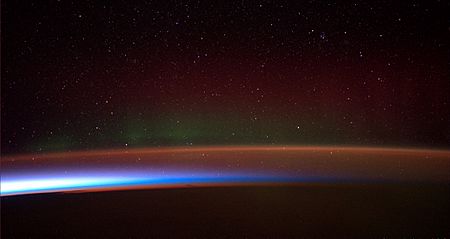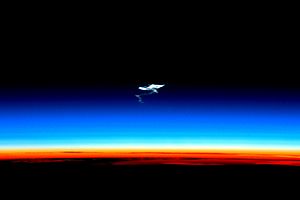Mesosphere facts for kids


The mesosphere is like the middle layer of Earth's atmosphere. It sits right above the stratosphere and below the thermosphere. It's the third layer as you go up from the ground. In this layer, it gets colder and colder the higher you go.
The mesosphere starts about 47 to 51 kilometers (around 29 to 32 miles) above the Earth's surface. It ends at a place called the mesopause, which is the coldest spot in our atmosphere! Temperatures there can drop to an amazing -143 degrees Celsius (-225 degrees Fahrenheit). The mesopause is usually found between 85 and 100 kilometers (about 53 to 62 miles) high.
Sometimes, people call the stratosphere and mesosphere together the "middle atmosphere." This area is roughly between 12 and 80 kilometers (about 7 to 50 miles) above Earth. The mesopause is also where the mesosphere meets the thermosphere, which is the next layer out.
You might also hear the term near space used for parts of the mesosphere. This isn't a strict scientific term. But it often refers to the area between where humans need a special suit to survive (around 19 km or 12 miles) and the edge of space (the Kármán line, about 100 km or 62 miles).
Contents
Temperature in the Mesosphere
Inside the mesosphere, the temperature drops as you go higher. This happens because there's less ozone to absorb the sun's energy. Also, carbon dioxide in this layer sends heat back out into space, which helps cool it down.
The very top of the mesosphere, called the mesopause, is the coldest part of Earth's atmosphere. Temperatures in the upper mesosphere can fall as low as about -100 degrees Celsius (-148 degrees Fahrenheit). These temperatures can change depending on where you are on Earth and the time of year.
What Happens in the Mesosphere?
The mesosphere is a very active place! It has strong winds that blow from east to west. There are also "atmospheric tides" and "gravity waves." These are like ripples that start lower down in the atmosphere and travel up into the mesosphere. When these waves get big enough, they break apart. This breaking helps move energy around the globe.
You can also see special clouds in the mesosphere called noctilucent clouds. These are shiny, wispy clouds that glow at night. They are the highest clouds in Earth's atmosphere.
The upper mesosphere also has a part of the ionosphere called the D layer. This layer only exists during the day. It forms when sunlight causes some gases, like nitric oxide, to become electrically charged. At night, without the sun, these charged particles go back to being normal molecules.
A special layer of sodium atoms also exists in the mesosphere. It's about 5 kilometers (3 miles) thick and is found between 80 and 105 kilometers (50 to 65 miles) high. These sodium atoms glow faintly, adding to the natural airglow of the sky. This sodium comes from tiny bits of meteors that burn up in the atmosphere. Scientists even use this sodium layer to create "guide stars" for powerful telescopes on the ground.
In 2018, a new type of aurora was discovered in the mesosphere. These green, wavy lights look like sand dunes and stretch towards the equator. They appear about 96 kilometers (60 miles) above the surface. Auroras happen when fast-moving particles from the sun hit molecules in our atmosphere. The green color of these "dune" auroras comes from sunlight hitting oxygen molecules in the mesosphere.
Millions of meteors enter Earth's atmosphere every year. They burn up in the mesosphere, leaving behind tiny bits of "meteoric smoke." Scientists think this smoke helps form the beautiful noctilucent clouds.
Exploring the Mesosphere
The mesosphere is a tricky place to study. It's too high for regular aircraft or even most balloons. The highest a balloon has ever gone is about 53 kilometers (33 miles), which is only the very bottom of the mesosphere. But it's also too low for satellites to orbit because there's still too much air, which would slow them down.
Because it's so hard to reach, scientists mostly study the mesosphere using special sounding rockets. These rockets can only take measurements for a few minutes before falling back to Earth. This is why the mesosphere is sometimes jokingly called the ignorosphere – because we don't know as much about it as other layers!
Scientists are very interested in understanding strange things that happen in this layer. These include red sprites and blue jets, which are types of electrical flashes that happen high above thunderstorms. They also study noctilucent clouds and how air moves in this layer.
On February 1, 2003, the Space Shuttle Columbia broke apart when it was re-entering Earth's atmosphere. This happened at an altitude of about 62 kilometers (39 miles), which is in the lower part of the mesosphere.
Things You Can See in the Mesosphere
- Airglow
- Atmospheric tides
- Ionosphere (D layer)
- Meteors
- Noctilucent clouds
- Polar aurora
- Sprite (lightning) (a type of lightning)
- Upper atmospheric lightning (other bright flashes)
Images for kids
-
The Space Shuttle Endeavour flying between the stratosphere and mesosphere. The troposphere, with clouds, looks orange.
-
An astronaut on the International Space Station sees red sprites (lightning) in the mesosphere, just below the airglow.
See also
 In Spanish: Mesosfera para niños
In Spanish: Mesosfera para niños
- Aeronomy
- Amateur radio high-altitude ballooning
- Geospace
- High altitude




